The opening of a city’s new rapid transit line is always a cause for celebration. In the case of Jakarta, the megacity’s notorious traffic and a notable lack of rail rapid transit lines (excluding the excellent KRL Commuter lines) means any new rapid transit line in the city is accompanied by some excitement and automatically gets the spotlight.
The latest addition to Jakarta’s small stable of rapid transit systems is the Jabodebek Light Rail Transit (“LRT“), having opened on 28 August 2023. During a trip to Jakarta last year, I had the chance to have a look at the then 4-months old system to see how it compared to other equivalent Metro lines.
Unfortunately, my first impressions of the brand new line were not all great.
Line Specifications and Route Profile
The system’s specifications on paper is pretty standard for a Metro line: Trains run at a top speed of 90km/h on mostly elevated standard gauge tracks (1,435mm) with a total length of 44.5km, and power delivery is via a 750V DC third rail.
Two separately branded lines make up the Jabodebek LRT – the Cibubur Line (25.94km) and the Bekasi Line (29.54km), coloured blue and green respectively on maps. Both lines share a common section that diverges to run as two separate branches (albeit branded as separate lines). Uniquely for a Metro line, the Jabodebek LRT is operated by PT Kereta Api Indonesia (PT KAI) – the Indonesian national railway company.
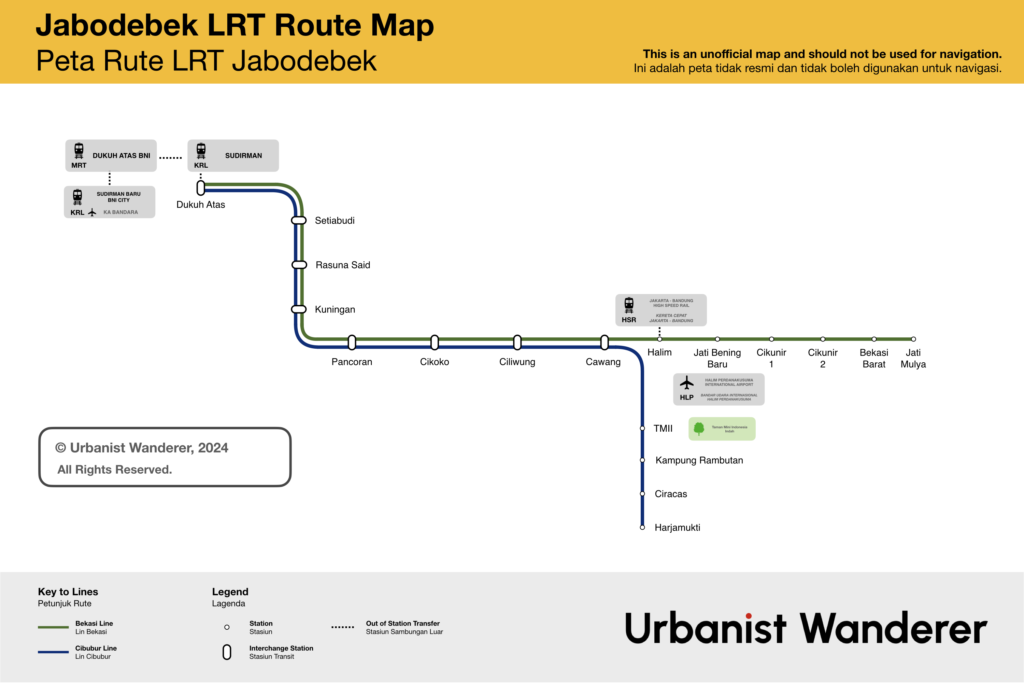
The Jabodek LRT begins at Dukuh Atas in central Jakarta, and immediately navigates a rather winding curve south passing Setiabudi, Rasuna Said and Kuningan stations above H R Rasuna Said Street (Jalan H R Rasuna Said). This is the first of 4 tight curves on the system’s alignment.
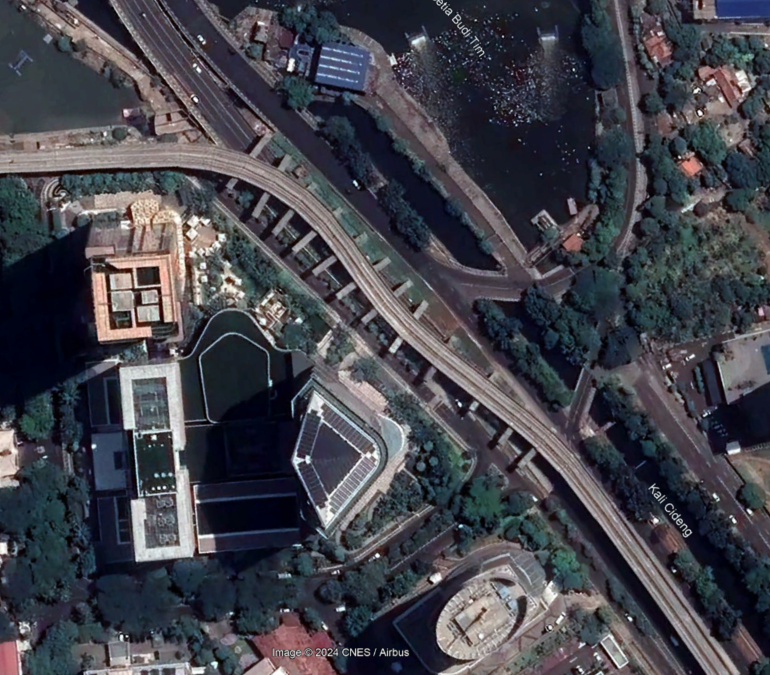
The alignment then curves sharply left to run above and alongside the Cawang-Grogol Tolled Road (Jalan Tol Cawang Grogol), passing Pancoran, Cikoko, and Ciliwung stations.
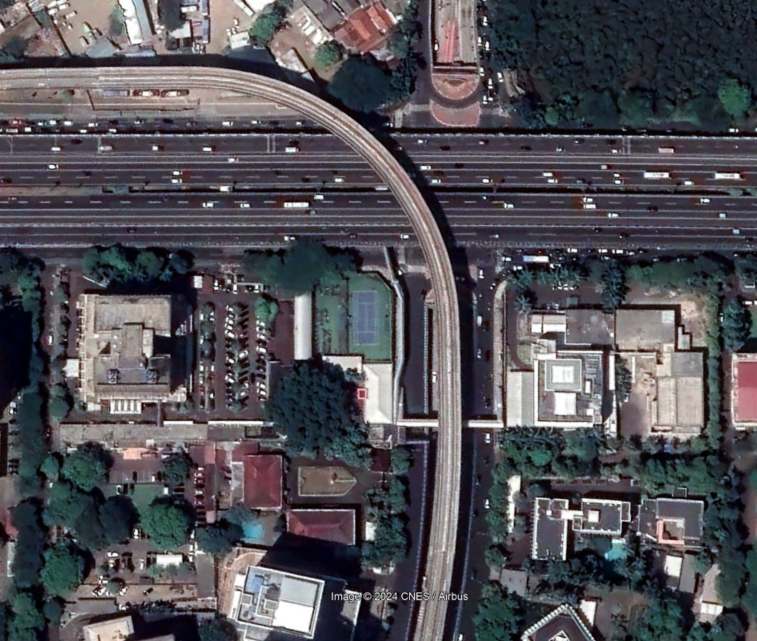
The tracks split up right before Cawang station, a substantially sized station with four platforms offering an interchange between both lines. The two branches then head in separate directions – the Cibubur Line turns very sharply south again running above and alongside another tolled road connecting TMII (Taman Mini Indonesia Indah), Kampung Rambutan, and Ciracas before finally terminating at Harjamukti station in the far south of the megacity.
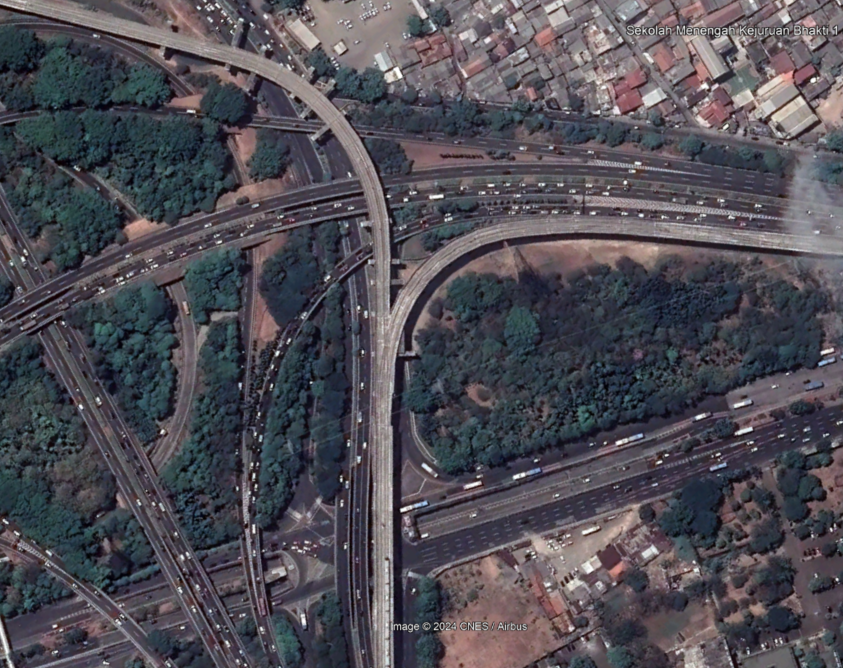
The Bekasi line also turns sharply left and continues eastwards after Cawang station. with the first stop being Halim (connecting to the Jakarta – Bandung HSR), Jatibening Baru, Cikunir 1, Cikunir 2, Bekasi Barat, and finally terminating at Jati Mulya in the east. The entirety of the alignment between Cawang and Jati Mulya runs above and alongside tolled roads, beginning with the Jakarta – Cikampek Toll Road (Jalan Tol Jakarta Cikampek) and subsequently the Sheikh Mohamed Bin Zayed Elevated Toll Road.
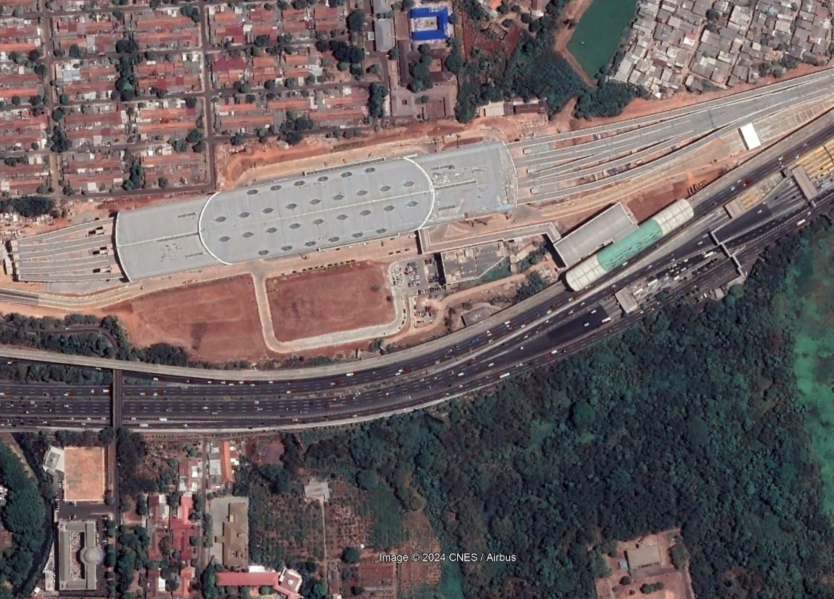
What’s with the name: “Jabodebek” is an acronym of Jakarta, Bogor, Depak, Bekasi – the urban locales of Jakarta served by the system.
Jabodebek LRT Rolling Stock
The Jabodebek LRT uses a fleet of 31 six-car trainsets made by local manufacturer PT INKA. These are painted in a distinctive red-white-black livery. Each train car has three leaf doors on each side, which is a pretty standard configuration for a Metro trainset.
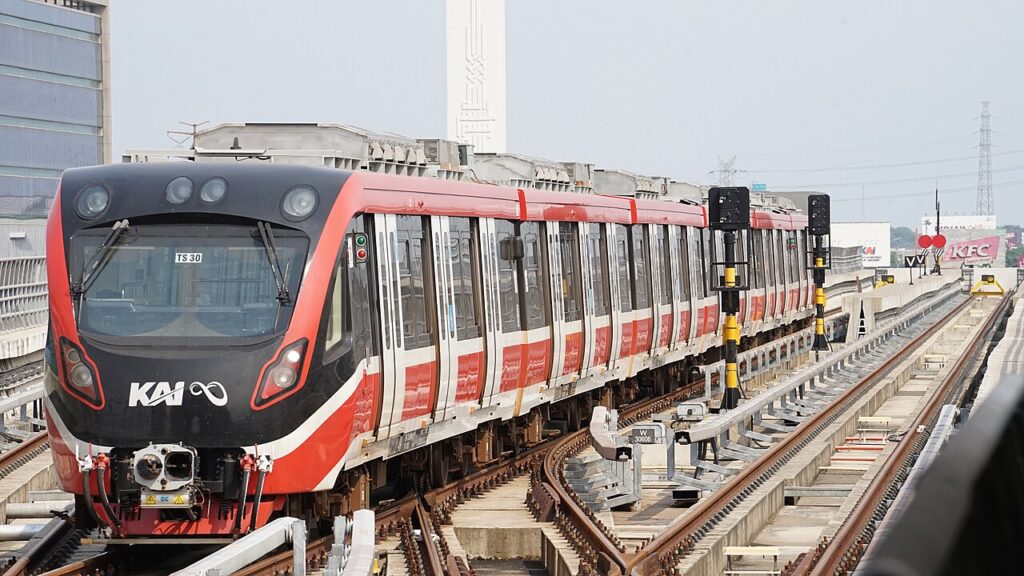
The interior of the trains are fitted out in a standard layout for Metro services. Seats are arranged in a typical longitudinal layout, with a standard complement of grabpoles and grabhandles installed above the seats throughout the train.
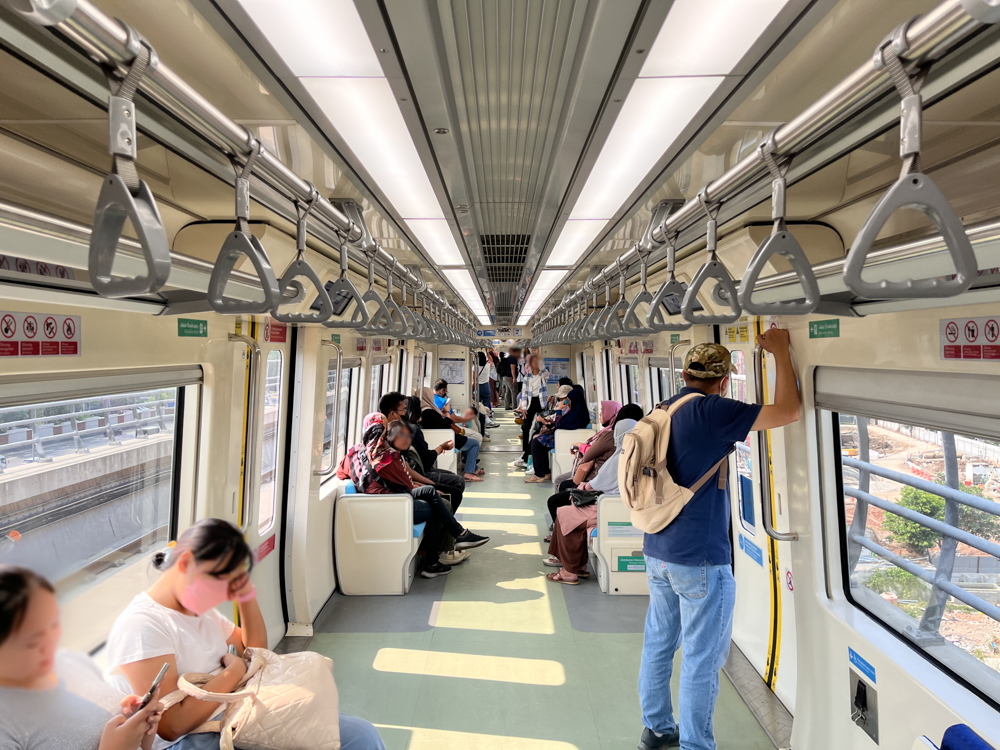
As is the norm for new Metro lines, the trains are fully walk-through thanks to the open gangways. The system is also fully automated although the trains still retain a driver’s cab built in at both ends of the trains.
Jabodebek LRT Station Architecture
The Jabodebek LRT stations are of a pretty standard elevated design with a modern tubular architecture. Access to the ticketing concourse is via stairs, escalators, and overhead bridges.
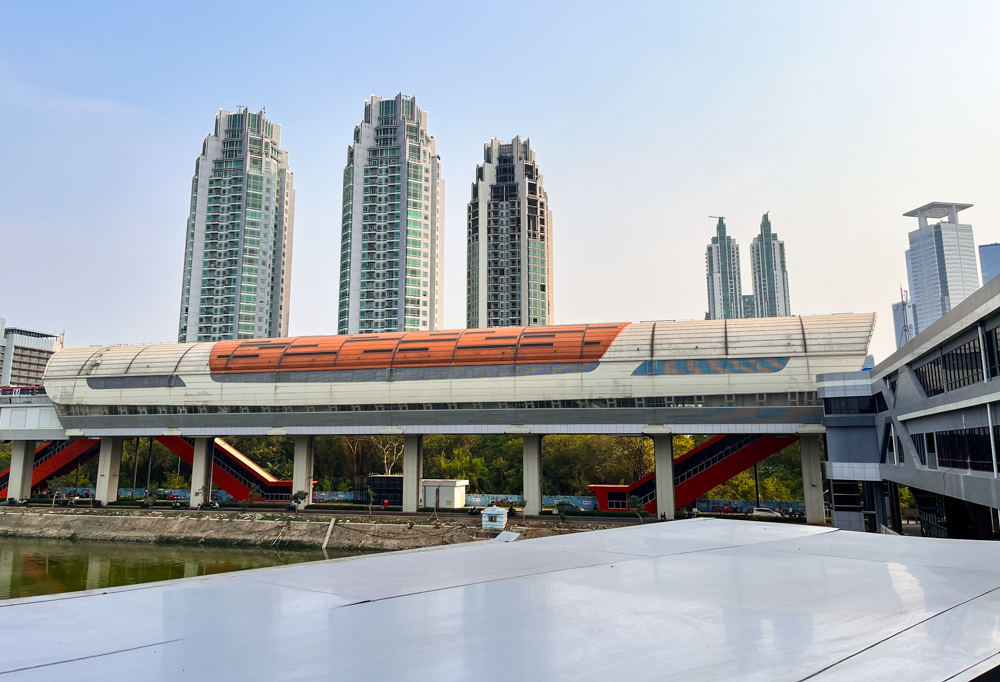

All stations feature half-height platform screen doors on the platforms.
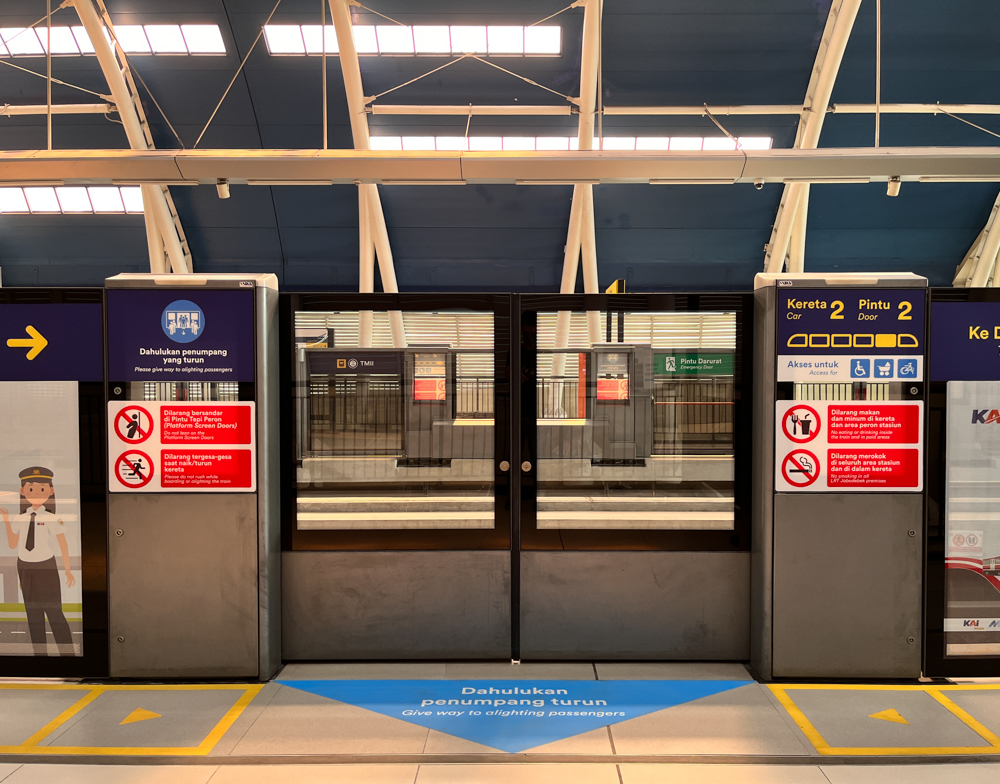
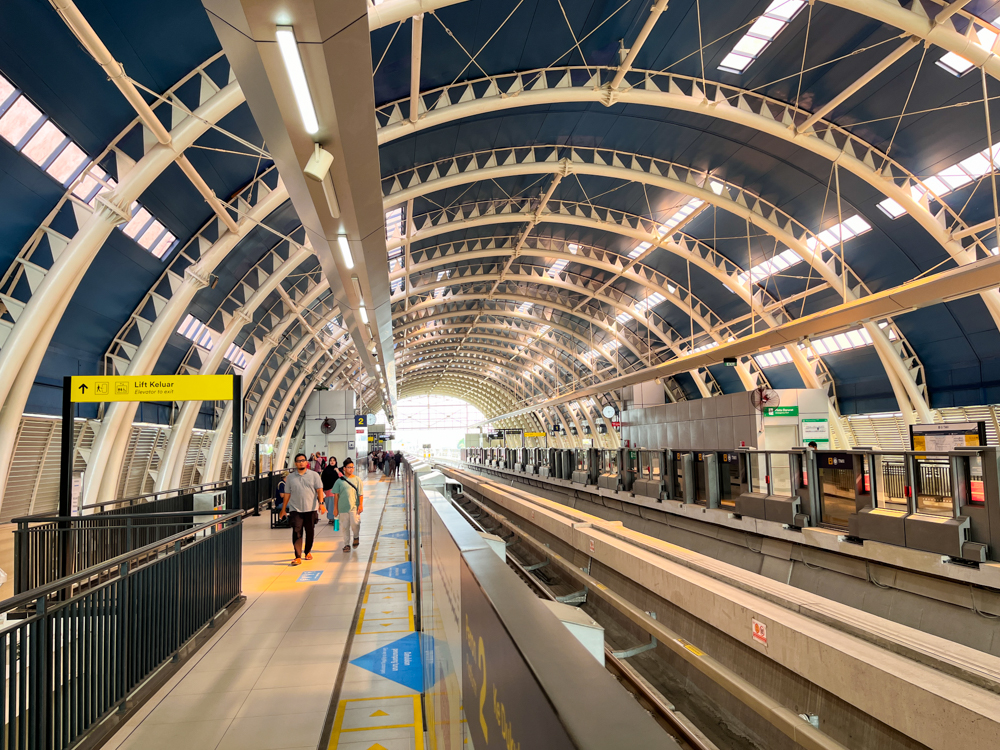
The ticketing concourses are of a pretty standard layout and design. I found it interesting that the ticket gates were turnstiles, which isn’t very common these days in Metro systems.
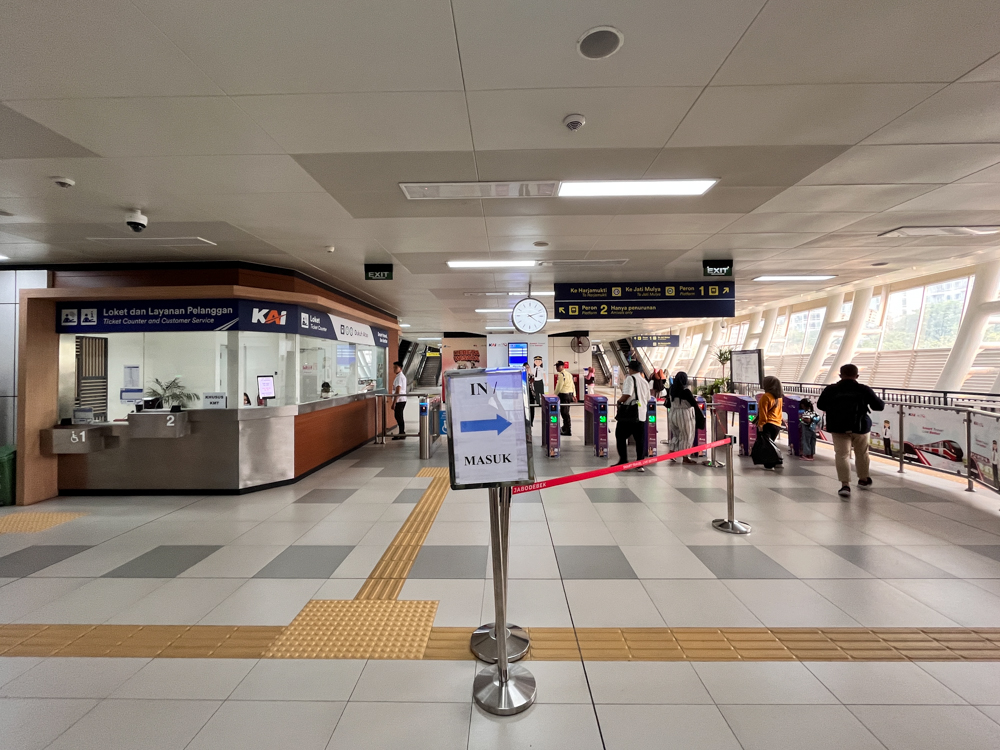
The Dukuh Atas terminus has a rather odd design where the ticketing concourse occupies the entirety of the middle section of the station. This means you cannot access the opposite ends of the station without buying a ticket and tapping into the system, which forces you to go back down to street level and walk further down the street to the escalators at the “correct” entrance.
What’s good about the Jabodebek LRT
In the interest of being objective, I’ll start off with what I do like about the Jabodebek LRT.
Signage & Wayfinding
One of my first impressions of the system was its well designed station signage with distinct palletes for separate categories of signage. Directional signage in the stations, for instance, stuck to a palette of yellow and white text on a dark blue background, and signage pointing towards exits and connections to other public transit utilises a palette of black text on a yellow background.
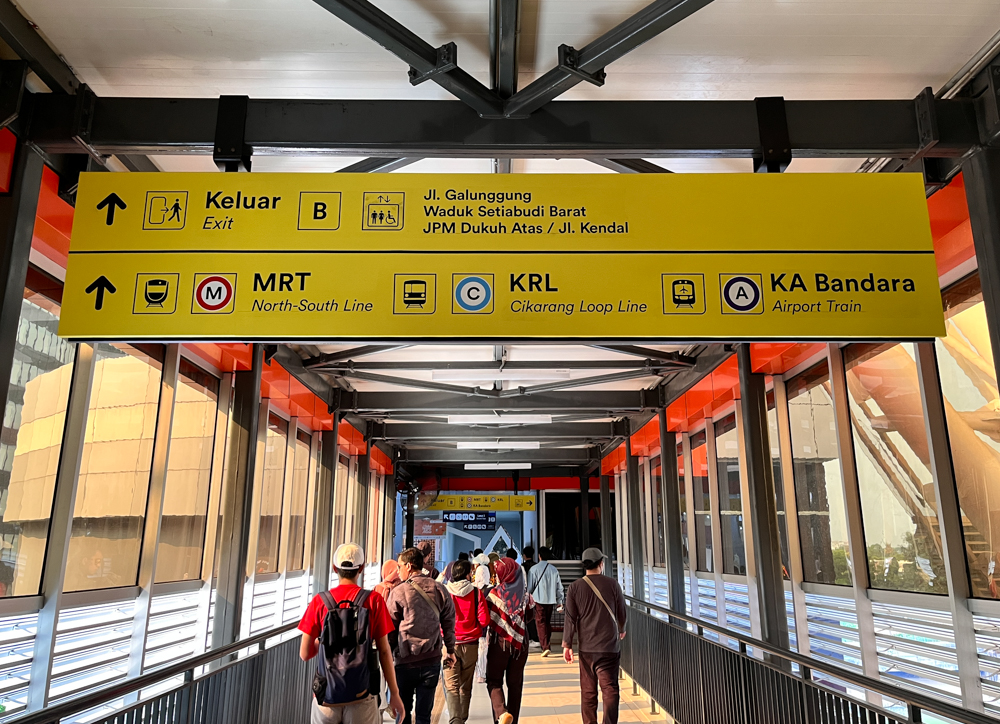
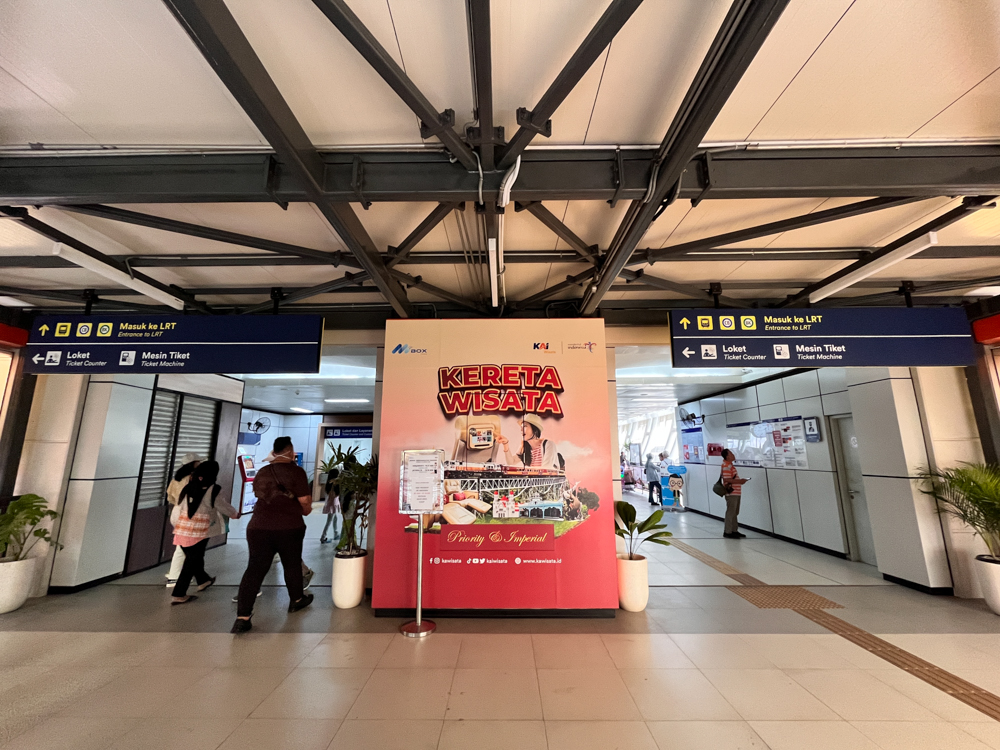
Every station is fitted with a board displaying line information, a Jakarta rail transit map, a station locale map, public transit connections, exit guides, and a station layout. These maps use a consistent blue-white colour pallette, and its content is well thought out and well designed.
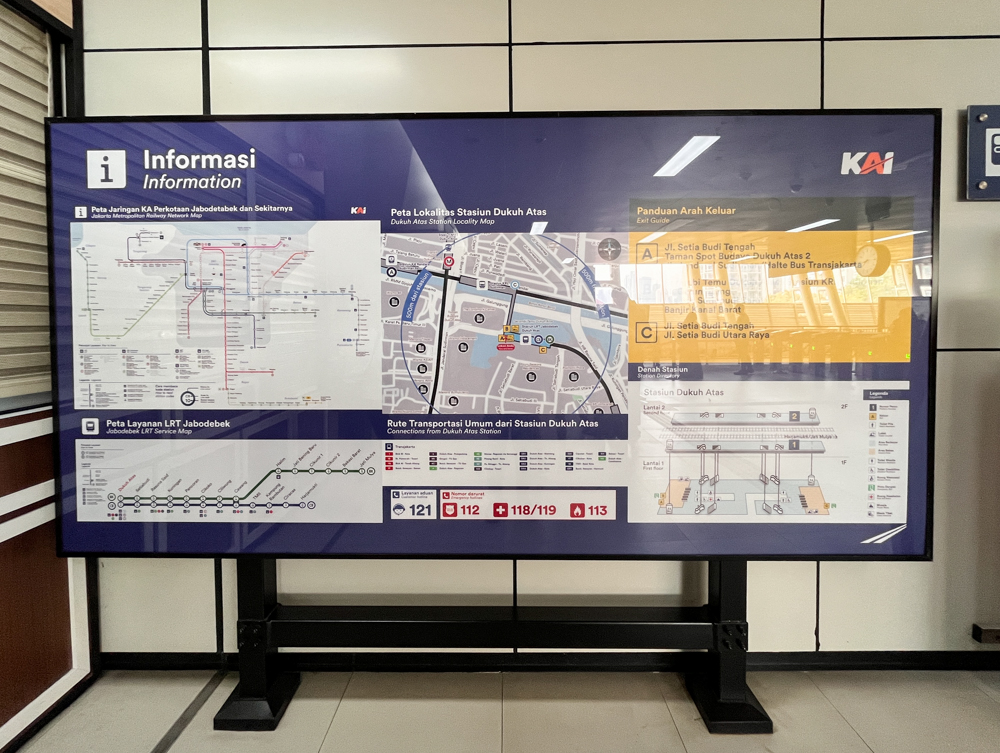
Station name boards utilise a consistent palette of dark blue text on a white background. The station name boards also accommodate the names of neighbouring stations and directional arrows on an inverse palette of white text on a dark blue background.
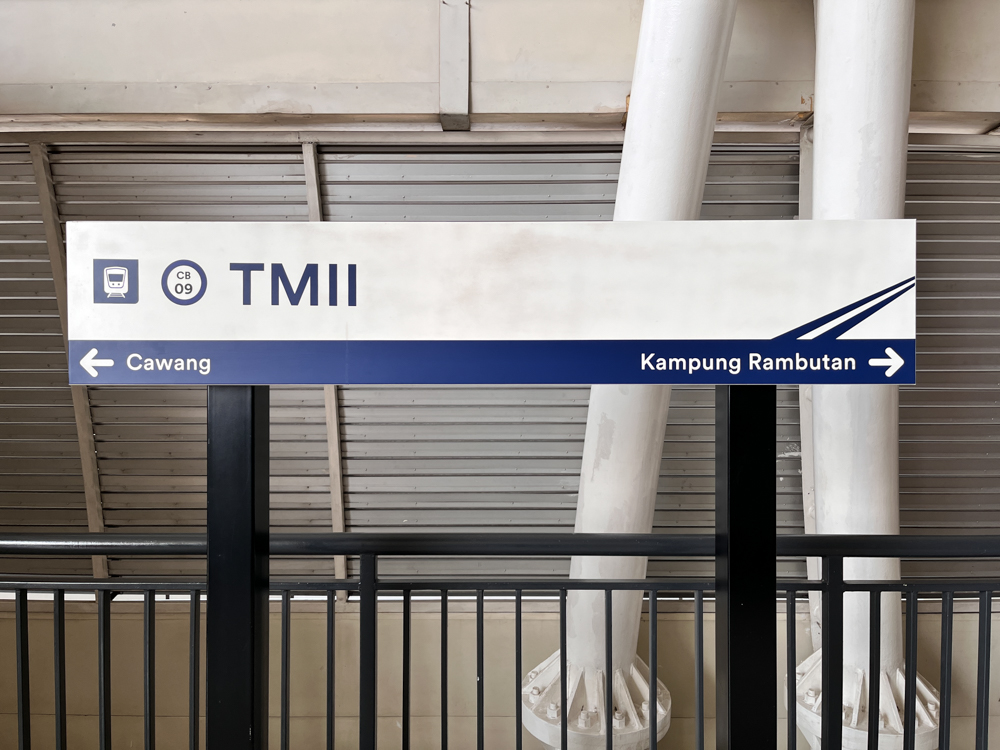
If these designs look familiar, that’s because they are identical / very similar to signage on the KRL Commuter lines, also operated by PT KAI. I guess if you already have good signage design on one system, you might as well port them over to your brand new LRT line.
The well designed wayfinding continues onboard the trains. Most visible are the LCD panels above the doors rotating between a series of informational displays, showing:
The line’s terminus …
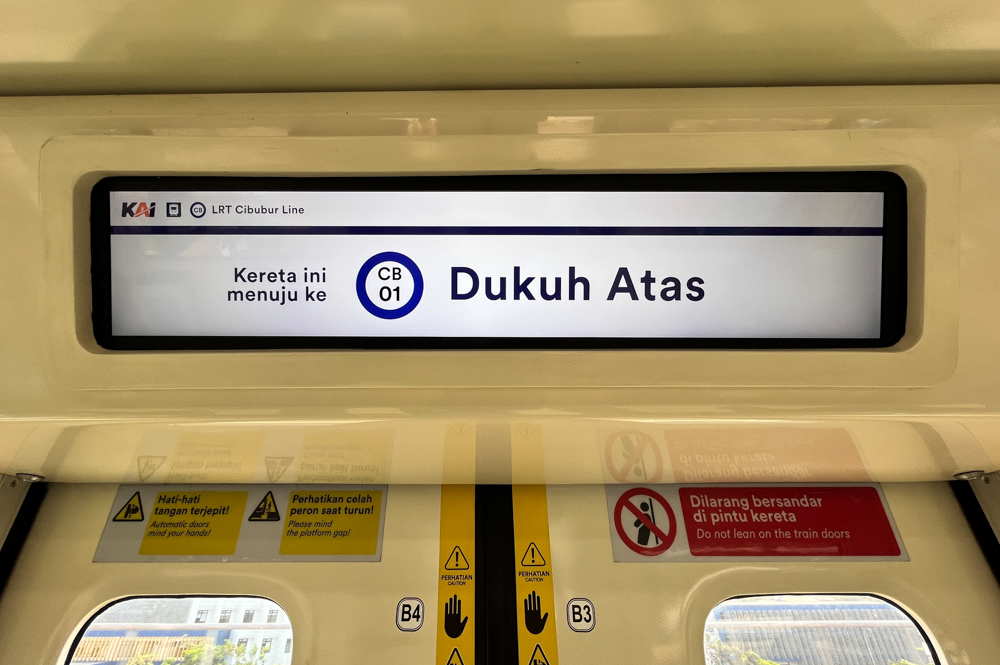
… the next station …
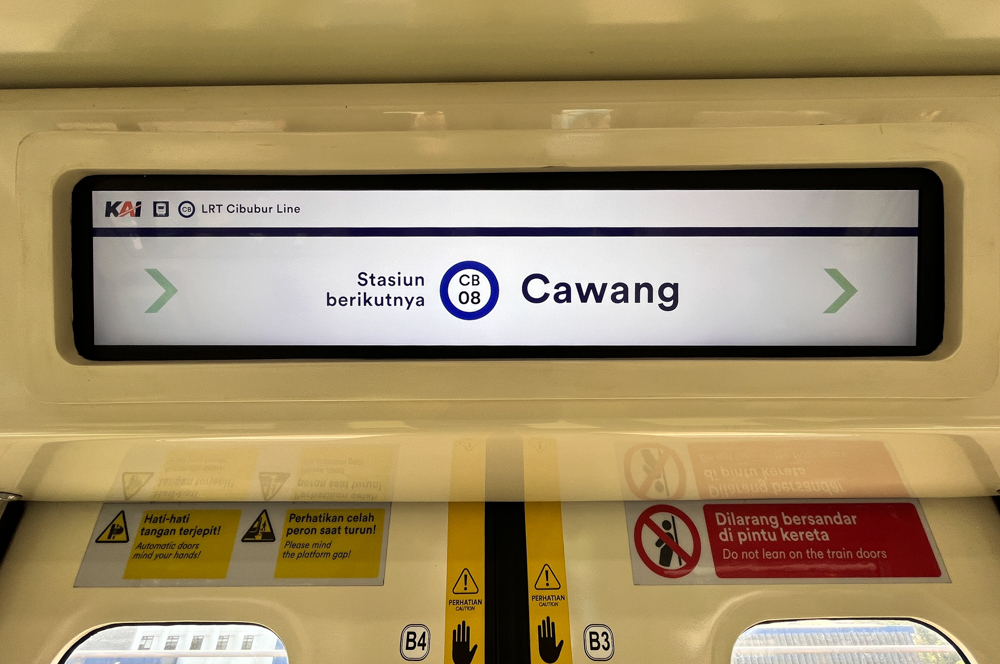
… a route diagram with a directional arrow …
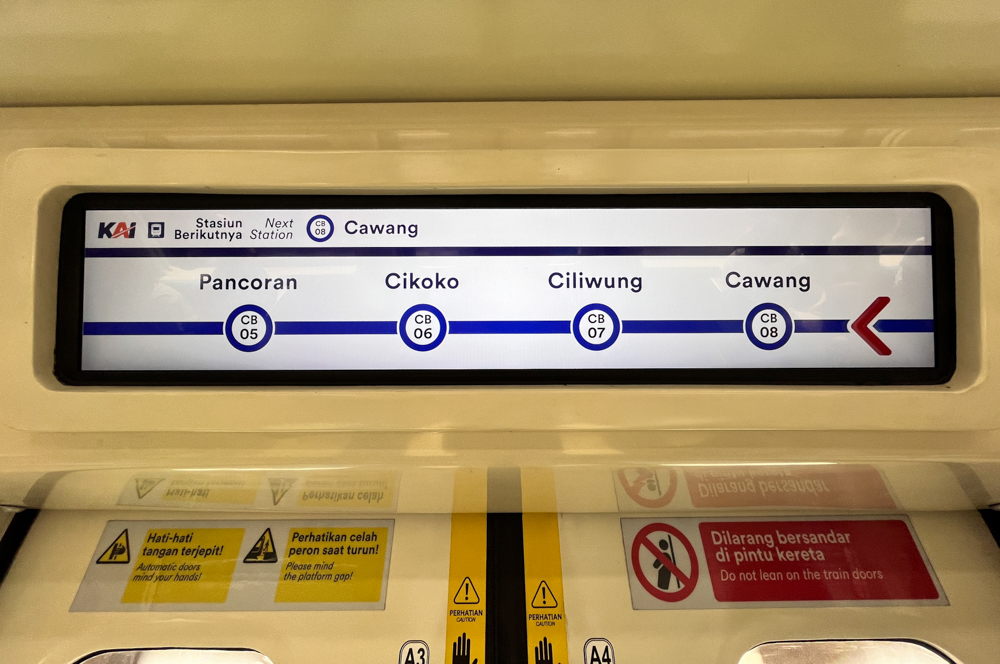
… transfer information for other public transit services at a station …
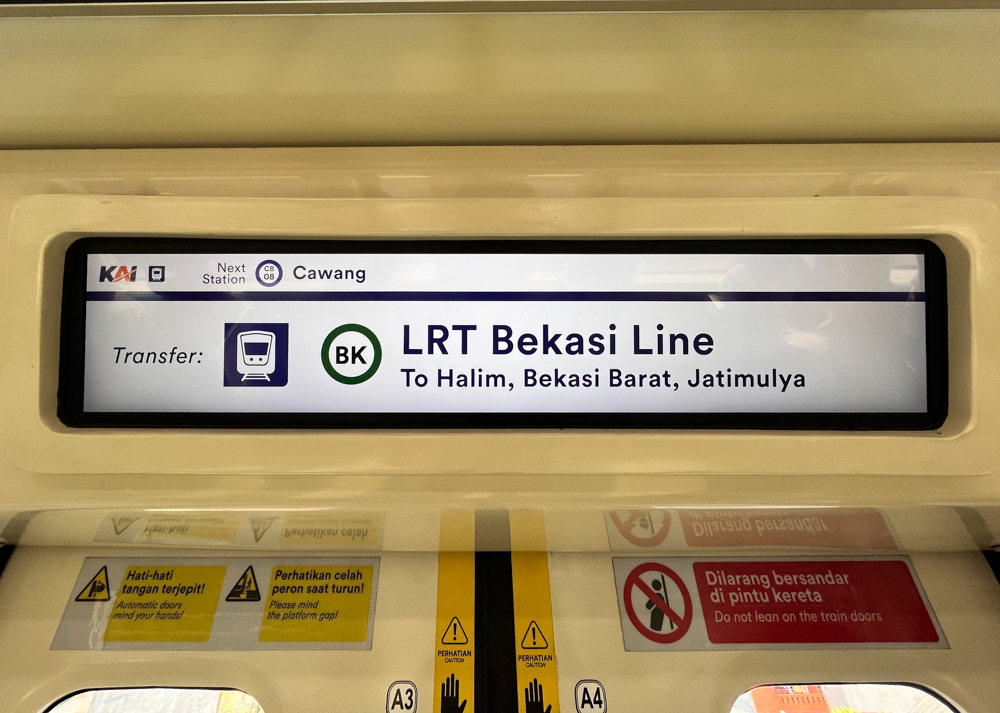
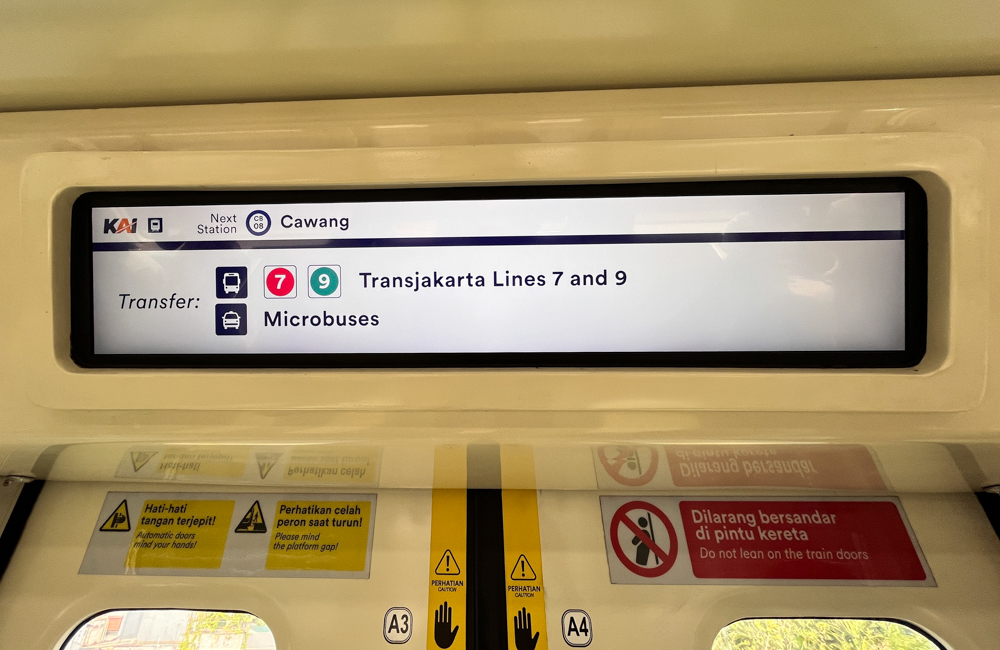
… and the position of platform escalators in relation to the train’s carriages.
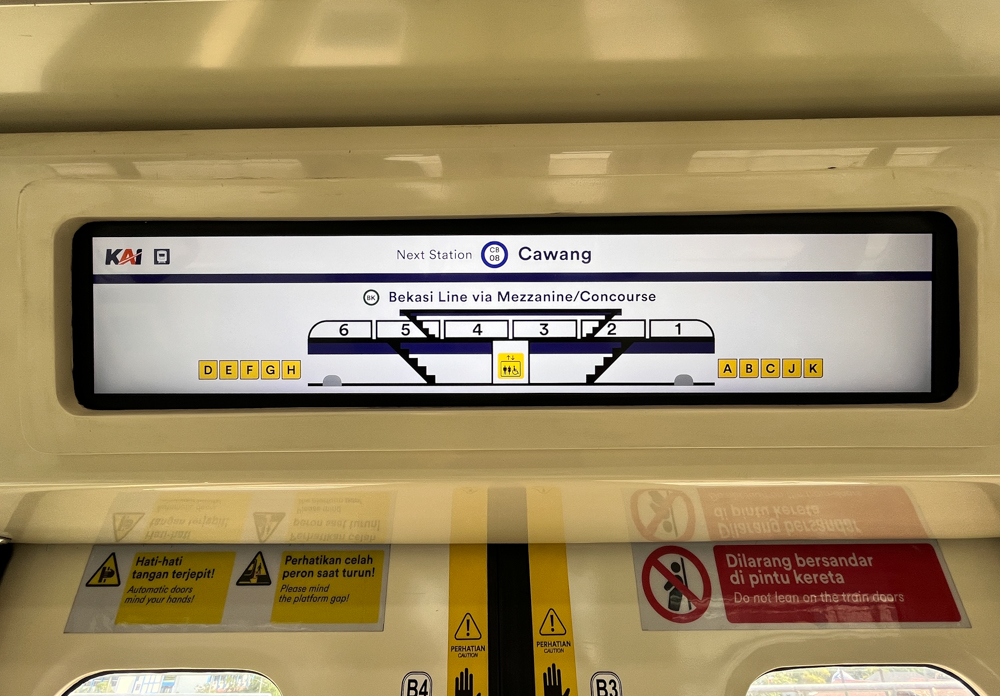
The level of information contained in the onboard displays are quite impressive, as the same level of detail isn’t seen in some of the region’s more established rapid transit networks. Kuala Lumpur’s new MRT lines, for example, introduced similar LCD infographic displays in late 2016, but they are not on the same level as the ones on the Jabodebek LRT.
Commercial Integration
Two stations have a greater focus on commercial outlets than the rest of the system. The first is the Dukuh Atas terminus, with its connecting bridge across the Ciliwung River housing a substantial commercial space with a pretty impressive selection of food stalls. As the bridge connects the LRT station to the Sudirman KRL Commuter station and the BNI City MRT station, these outlets are guaranteed a high level of foot traffic daily.
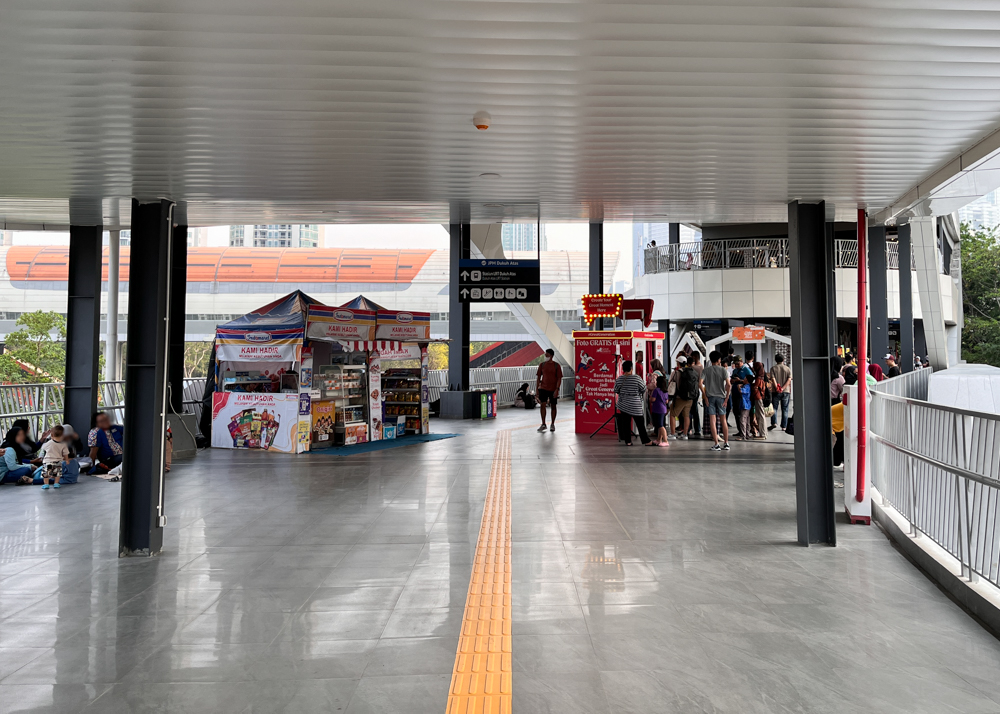
The second is the TMII (Taman Mini Indonesia Indah) station on the Cibubur Line with an added structure that, from the outside, resembles a very small premium mall. I’m not entirely sure what the commercial strategy is, but at the time of my visit the space was essentially a rather sparse collection of food stalls in a nicely designed space.
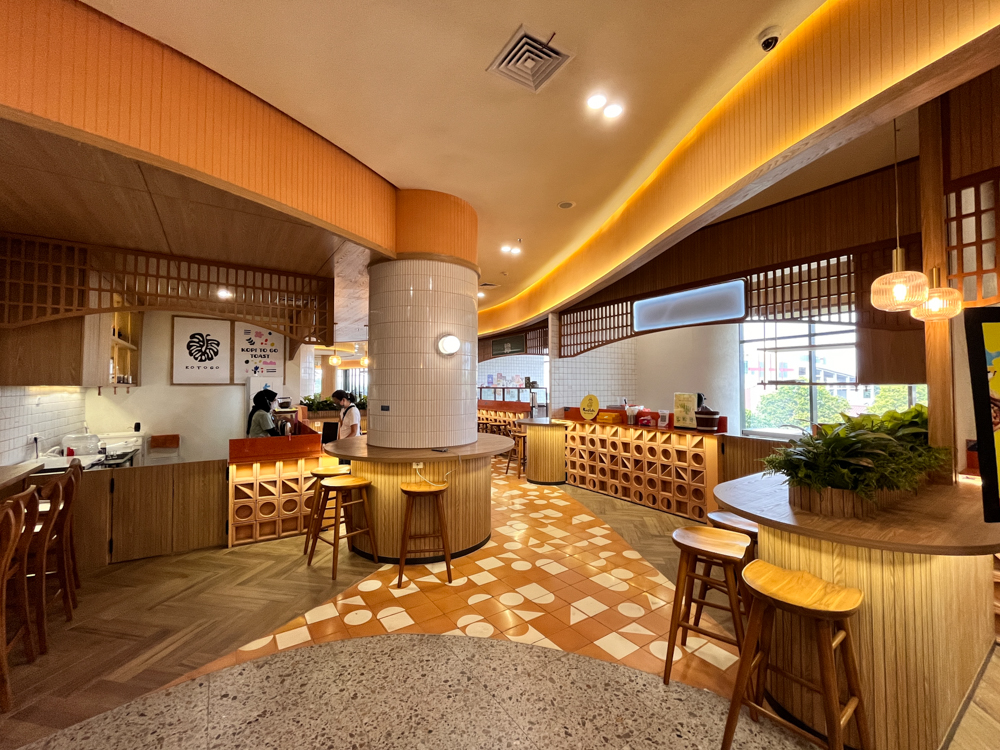
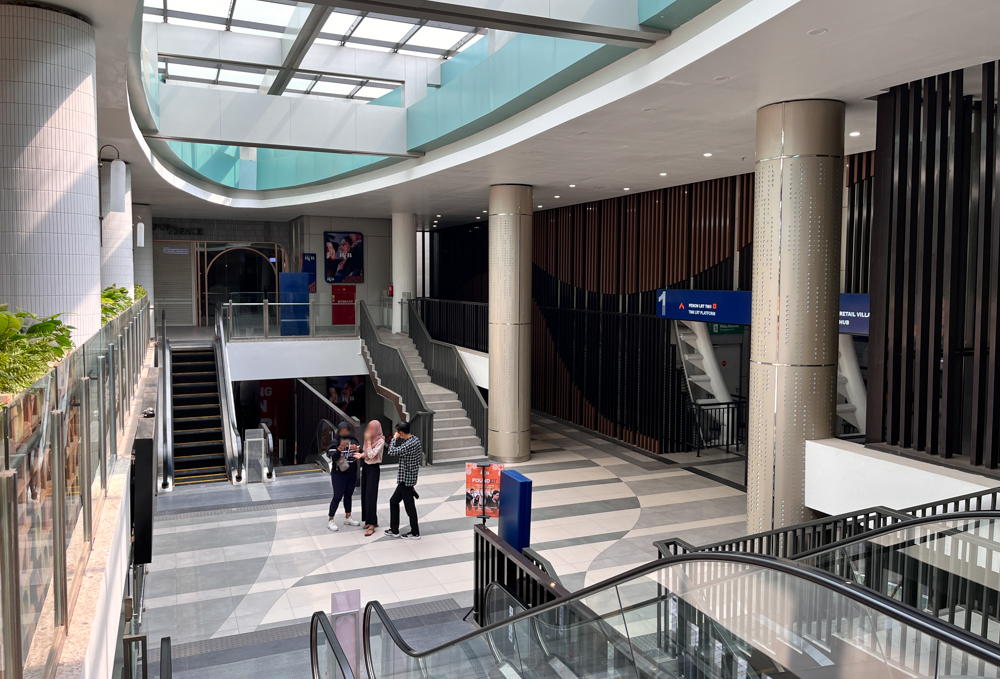
Commercial integration with rapid transit stations are of course nothing new, but I thought these were particularly well executed examples. Although I suppose only time will tell if the commercial space in TMII station can take off.
What I don’t like about the Jabodebek LRT
The Jabodebek LRT is hamstrung by quite a few notable flaws.
Lackluster Line Frequency
Despite being a Metro line, the Jabodebek LRT runs on frequencies / headways that resemble mainline commuter trains more than actual Metro operations. At the time of my visit in October 2023, the Sunday headway was 9 minutes; As of April 2024, both lines of the Jabodebek LRT run on a published schedule that seems to be based on a consistent 12 – 13 minutes frequency throughout the day (both weekdays and weekends), and a rather sparse 19 minutes frequency during the morning rush hours. I find the existence of this published schedule to be really interesting, as Metro lines do not typically run on a fixed timetable like this.
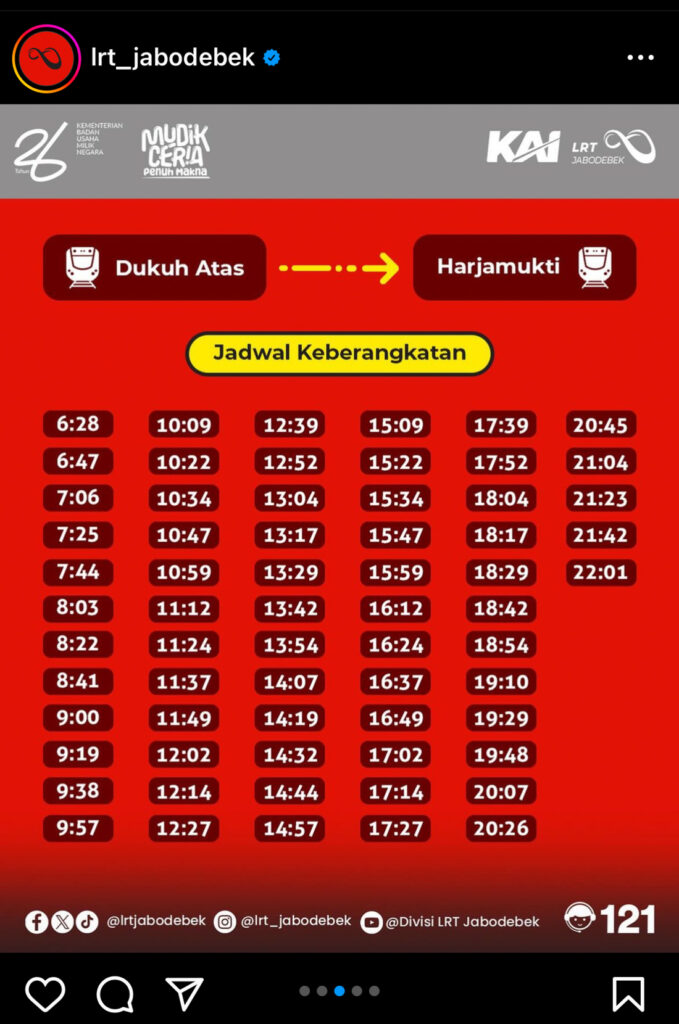
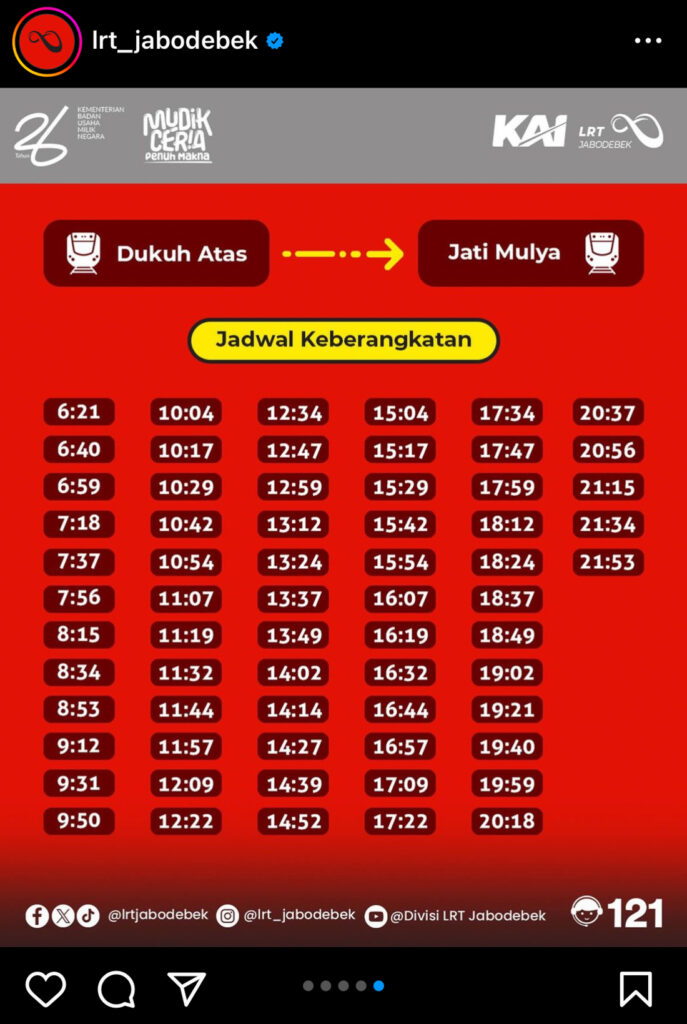
An Instagram post earlier this year alludes to headways of 7.5 minutes for the Dukuh Atas to Cawang section and 15 minutes for the branches, which also isn’t exactly ideal for a Metro line of a major city.
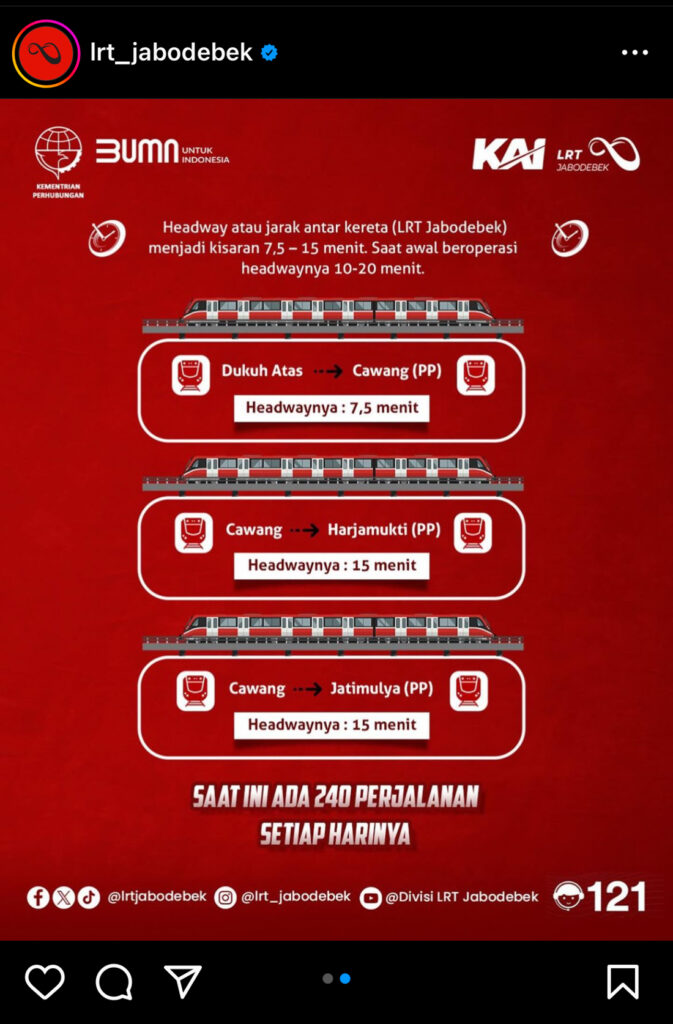
For comparison, here are some published frequencies of Metro lines in nearby Singapore and Kuala Lumpur. These frequencies are arguably more usable than those of the Jabodebek LRT.
Singapore
Singapore’s more established MRT network advertises an island-wide peak hour frequency of 2 – 3 minutes and 5 to 7 minutes off-peak.
| Line | Peak | Off-Peak |
|---|---|---|
| All Lines | 2 – 3 minutes | 5 – 7 minutes |
Kuala Lumpur
Published frequencies for Kuala Lumpur’s MRT and LRT lines differ across the various lines and are generally pretty decent. However, from personal experience and public reputation, the actual frequencies for the LRT Kelana Jaya Line and the city’s two MRT lines can sometimes run closer to the Jabodebek LRT frequencies due to what seems to be train availability issues.
| Line | Peak | Off-Peak / Weekends |
|---|---|---|
| LRT Kelana Jaya Line | 4 minutes | 7 minutes |
| MRT Kajang Line | 6 minutes | 10 minutes |
| MRT Putrajaya Line | 5 minutes | 10 – 12 minutes |
The Ampang – Sri Petaling LRT line has a route structure similar to the Jabodebek LRT, but has slightly different frequencies across its two branches and the common section in the Central Business District (CBD). It has pretty good frequencies in the CBD sections, though the wait is slightly longer in the outlying branches.
| Line | Peak | Off-Peak / Weekends |
|---|---|---|
| LRT Ampang – Sri Petaling Line (CBD Section) | 3 minutes | 5 minutes |
| LRT Ampang – Sri Petaling Line (Branches) | 6 minutes | 10 minutes |
All of Kuala Lumpur’s Metro lines do suffer from a lackluster 10 minute frequency on weekends, which is frankly a good way to discourage usage outside of daily work commuting. Not great at all.
Ride Quality & Flawed Alignments
The system’s ride quality also leaves much to be desired. During my ride from TMII to Dukuh Atas, I noticed the trains kept speeding up immediately after leaving the station before noticeably slowing down, and it would then continue on to the next station at the slower speed before slowing down again and crawling into the station. It felt a bit like the automation wasn’t quite sure what speed it should be driving the train at. I later came across a CNA news article quoting an Indonesian Deputy Minister as describing all 31 trainsets having differently spec-ed speed and braking mechanisms from each other (how is this even possible?) so this may have something to do with it.
I also noticed that trains were crawling slowly around every turn in the alignment. I later looked at a map and noticed that the Jabodebek LRT’s alignment had much tighter turning radii than usual for a Metro line at its curves. The same CNA article also quotes the Indonesian Deputy Minister describing the tighter turning radius in one of the curves as the result of a “miscommunication” between the construction firm and other companies involved with the project. The end result is that trains are limited to a speed of 20km/h when passing the curve in question. Now how exactly does that happen?
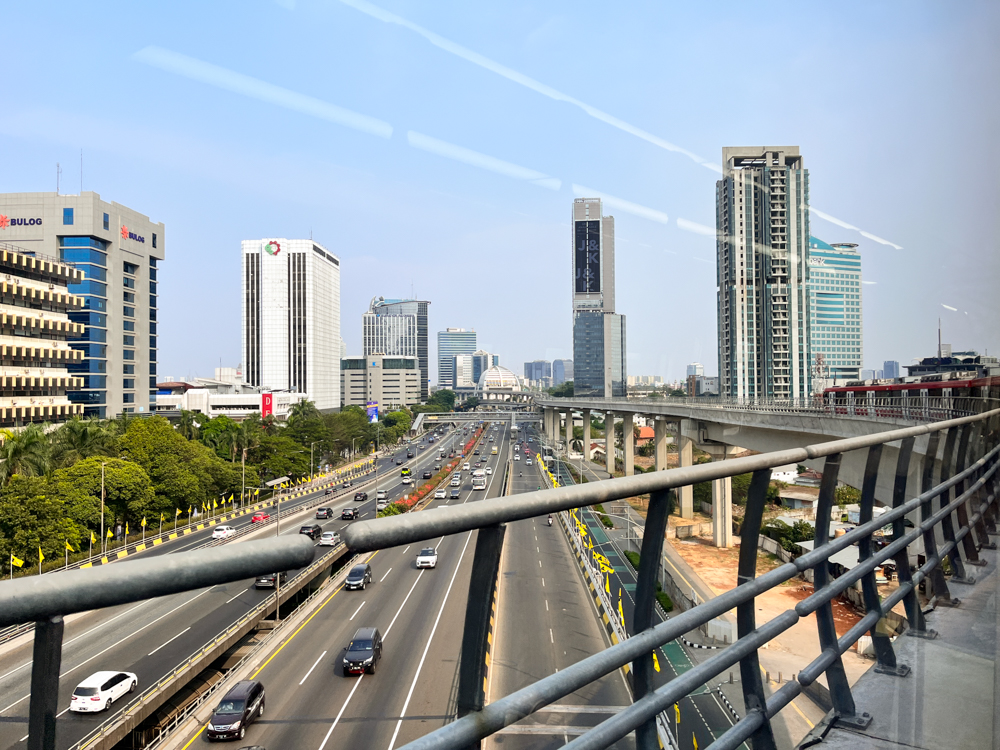
A final oddity I noticed is that my train was held up for a significant length of time at the curve just before Cawang station – the merging point between the Bekasi and Cibubur lines. I peered out the window and noticed that our Cibubur line train was holding for a Bekasi line train from Jatimulya to complete its crawl into the station, almost like it was a mainline railway junction. A look at a satellite map reveals why – While Cawang station is a multiplatform station offering a standard cross-platform interchange between the two branches, it handles this rather inelegantly by forcing both lines to merge back into a double-track after the station before splitting into two separate double tracked branches.
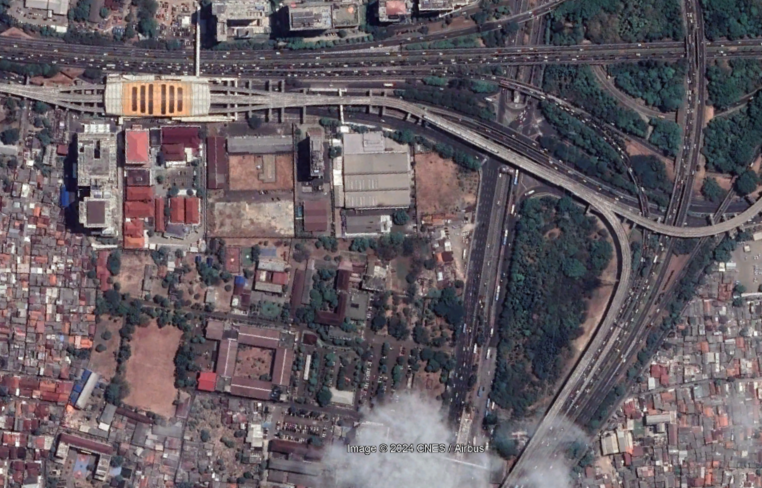
This track layout means that trains bound for Dukuh Atas on the Cibubur line will always conflict with their counterparts heading the same direction on the Bekasi line, as well as Bekasi line trains heading the opposite direction towards Jatimulya. This then forces Cibubur line trains to hold at the curve while Bekasi line trains crawl in and out of Cawang station, in turn limiting train movements on the system. No wonder the frequencies are scheduled!
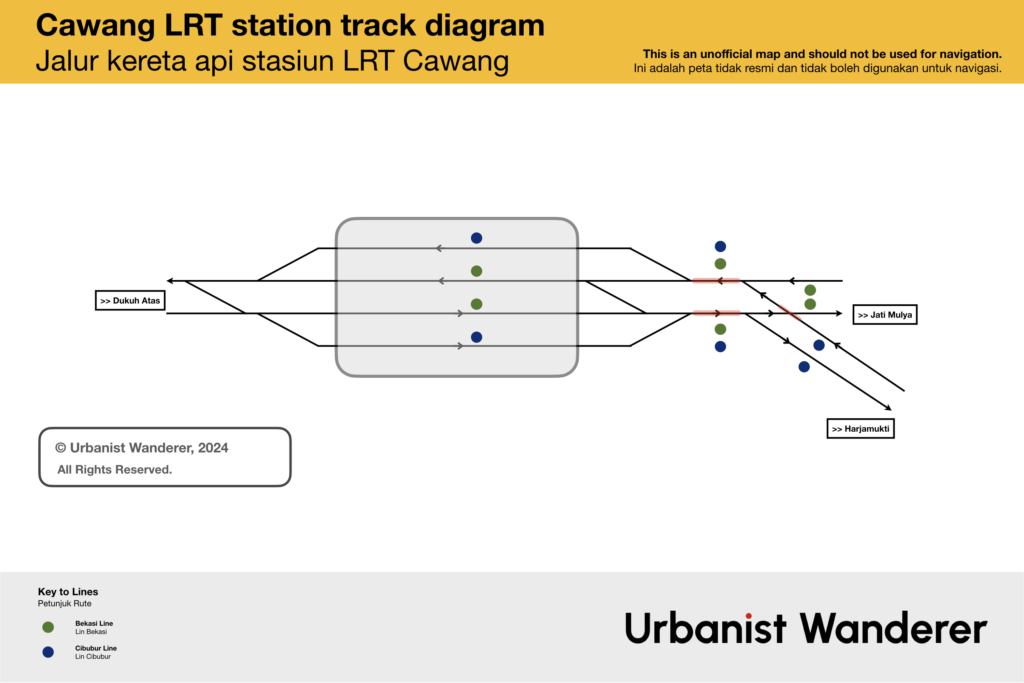
Now a flying junction would have been a much better solution, but I suspect the lack of space within the densely built up Jakarta urbanscape made it difficult to slot in two elevated tracks flying in and out of the station.
Lack of Ticketing Integration
The system also suffers from a lack of ticketing integration with the other rapid transit lines in the city. To be fair though, this is a more of a Jakarta-wide issue as its myriad of public transit lines were developed separately and are now run by separate companies. While you can pay for your train rides using one of the many locally issued cash cards, you cannot buy single tickets for journeys that require a transfer to another line. For example, if you want to connect from the Jabodebek LRT to the Jakarta MRT at Dukuh Atas, you have to buy two separate tickets for each leg of the journey.
It isn’t the end of the world, but it does make the journey less seamless than it could be. Jakarta did introduce a fare integration program named Jak Lingko featuring amongst others, a fare cap that you get by using special Jak Lingko branded cash cards for public transport. The problem is that not all public transport lines fall under the Jak Lingko program – As it turns out, the Jabodebek LRT doesn’t come under Jak Lingko so the fare cap doesn’t apply to journeys on the system, although you can still tap in with the Jak Lingko branded cash cards like a normal cash card.
At the time of my visit, the Jabodebek LRT’s systems did not support reloading Jak Lingko cash cards, so I bought a single cash ticket from TMII to Dukuh Atas instead. I’m still not sure if this single cash ticket is actually a reusable cash card or just a regular single use ticket.
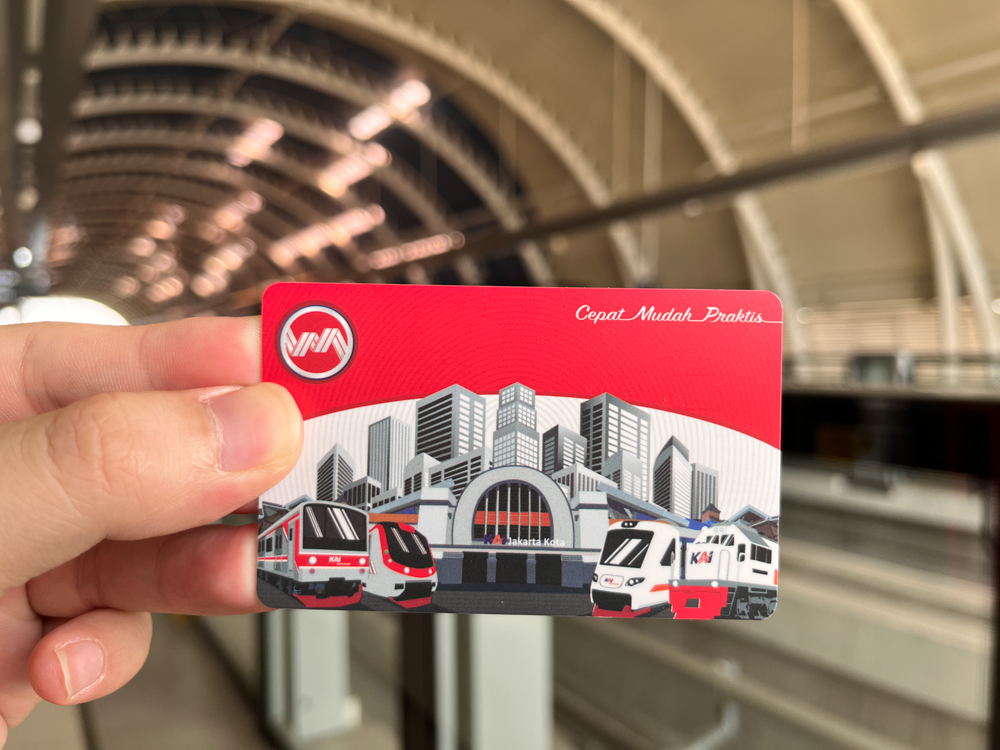
I thought the reloading issue was isolated only to TMII station, but then I discovered at Dukuh Atas that the issue was system-wide. The ticket machines there also did not support reloading cash cards, and the counter staff couldn’t seem to reload my Jak Lingko card no matter how many times they tried manually. It ended up being a very frustrating afternoon.

My experience with the Jak Lingko card also led me to discover another oddity involving the physical connection between Dukuh Atas LRT station and Sudirman KRL station, but that’s best covered in a separate post.
Final Thoughts
The Jabodebek LRT is a modern rapid transit line and is certainly a step in the right direction for Jakarta. Though, I do wonder how much of its potential has been curtailed simply because of the various easily avoidable issues it has. Some, like the slow frequencies and lack of ticketing integration can be fixed with better signalling, more (and better) trains, and an overhaul of the city’s public transport fares and ticketing system. But the system also features problems that aren’t easily fixed at this stage – how do you fix a very tight curve radius and a bad junction layout without shutting down the entire system for years?
The Jabodebek LRT isn’t a bad system at all, and there definitely is room for further improvement. I just hope that it isn’t too flawed to end up being a permanent disappointment.
Leave a Reply